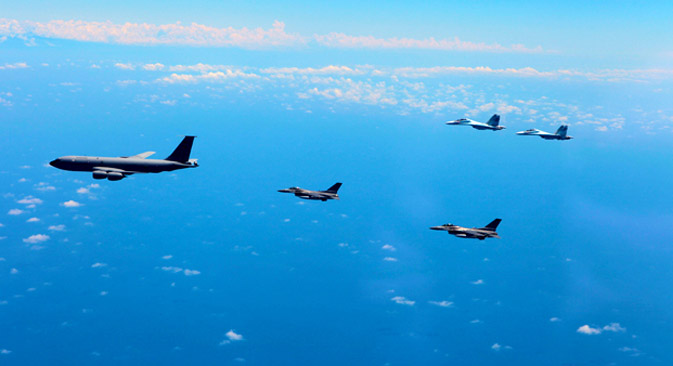
NATO and Russian Federation fighter jets escort an aircraft during exercise Vigilant Skies 2011. Source: NATO-Russia Council
The differences between Moscow and Brussels on the Syrian conflict have been grabbing headlines recently. The potential deployment of U.S. missile defenses in Europe was a sore spot before that.
All of this has somehow overshadowed the actual efforts that, for over a decade, have been put into bringing NATO and Russia closer together — since the Russia-NATO Council was established in 2002.
Joint exercises to salvage submarine crews or to fight drug trafficking in Central Asia pass under the radar. Press reports about counter-piracy operations near the Horn of Africa rarely mention that NATO and Russian sailors serve “vessel side by vessel side” there, to provide security for global trade.
Low-profile yet painstaking and ongoing work on WMD nonproliferation falls out of the media focus too.
On Aug. 27 and Aug. 29, in the skies between Russia’s Chukotka and America’s Alaska, the Russian, U.S. and Canadian air forces successfully completed joint exercises under a scenario identical to the Vigilant Skies. Although the U.S. and Canada are NATO members, these exercises were tri-lateral and outside of CAI’s scope.
There is also the invaluable and vast intelligence assistance Russia’s special services provided to the international coalition that engaged the Taliban in Afghanistan in 2001. There are more examples of productive cooperation in “responding to real rather than imaginary, Cold War-legacy challenges to the security of our nations,” to quote Yuri Gorlach, deputy head of the Russian Foreign Ministry’s Common European Cooperation Department.
However, according to Ludwig Decamps, chairman of the Russia-NATO Council’s task force, the Cooperative Airspace Initiative (CAI) is one of the most concrete among the Council’s projects. The initiative’s aim is to help achieve maximum coordination between NATO and Russia, in the event of a hijacking of civilian aircraft by terrorists.
Dozens of different agencies and thousands of personnel on both sides become involved in such situations — from air defenses and foreign services, to air traffic controllers and interceptor fighter jet pilots sent to force a “renegade” plane to land.
Aerial borders do make exercises more difficult. The lives of hostages or surface facilities that could be attacked by hijacked planes could face additional danger if counter-terrorist response is poorly coordinated.
CAI was originally based on the premise that a repeat of the tragic events of 9/11 should be prevented. No nation is capable of providing security in the skies singlehandedly: This is a common cause, in the opinion of both Brussels and Moscow.
US, Italy to compete in Russia’s next tank biathlon
Russia and NATO to run joint exercises and talk on missile defense
Late September marked the end of an active phase of the third annual CAI exercises. This year, the exercises were held in three areas at once — in the Arctic, near the Baltic coast and above the Black Sea. Russia partnered in these areas with NATO members Norway, Poland and Turkey, respectively.
As is customary for such exercises, a hijacking of a plane by terrorists was simulated, followed by an interception and forced landing by fighter jets and a neutralization of the terrorist threat. The simulated behavior of “hijacked” planes varied.
Russian Sukhoi-27 interceptors forced one plane originating from Poland to turn around in the skies above Kaliningrad, after the airliner’s crew managed knock the terrorists out on their own and hand the aircraft over to Polish fighter jets that accompanied it to a landing there.
With Turkey, the same scenario was played in reverse, as Turkish F-16s accompanied a hijacked aircraft above their territory and returned it to their Russian colleagues. The joint exercise with Norway was computer-modeled, which is no less useful for the development of mutual understanding. The exercises were coordinated simultaneously from Warsaw and Moscow.
“The missions — especially in the Kaliningrad area—were complicated by the simultaneous West-2013 exercises,” deputy commander of Russia’s Aerospace Defense Forces, Kirill Makarov, said at a press conference following the completion of the Vigilant Skies exercises.
Lt. Gen. Yevgeny Potapov, the exercise director from the Russian side and an executive of the National Anti-Terrorism Committee, pointed out that CAI is already improving “the security of thousands of international air travelers and millions of people on the ground.”
Yet the exercises are but the tip of an iceberg that is based on daily exchange of air-traffic data. According to the NATO representative Ludwig Decamps, “We have a system that has shown its operational value.”
What this actually means is that NATO and Russia are prepared for joint repulsion of airborne terrorist threats. At least this sphere of relations between the former Cold War rivals seems to be doing OK.
All rights reserved by Rossiyskaya Gazeta.
Subscribe
to our newsletter!
Get the week's best stories straight to your inbox